第九章模拟信号和数字信号的转换.
- 格式:ppt
- 大小:733.50 KB
- 文档页数:27
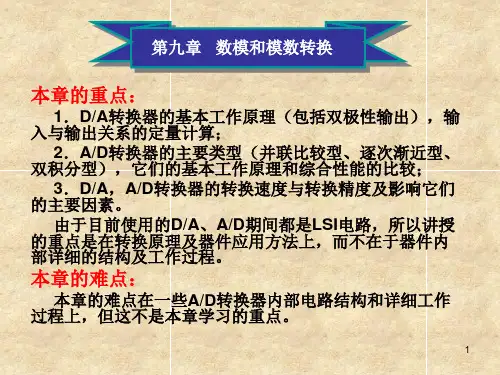
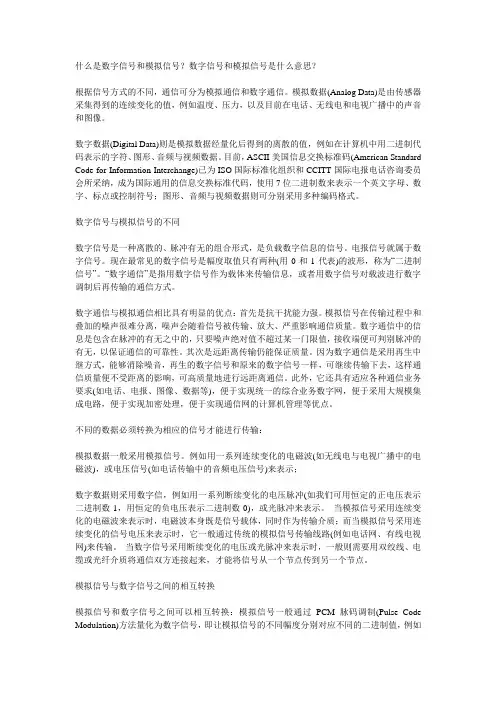
什么是数字信号和模拟信号?数字信号和模拟信号是什么意思?根据信号方式的不同,通信可分为模拟通信和数字通信。
模拟数据(Analog Data)是由传感器采集得到的连续变化的值,例如温度、压力,以及目前在电话、无线电和电视广播中的声音和图像。
数字数据(Digital Data)则是模拟数据经量化后得到的离散的值,例如在计算机中用二进制代码表示的字符、图形、音频与视频数据。
目前,ASCII美国信息交换标准码(American Standard Code for Information Interchange)已为ISO国际标准化组织和CCITT国际电报电话咨询委员会所采纳,成为国际通用的信息交换标准代码,使用7位二进制数来表示一个英文字母、数字、标点或控制符号;图形、音频与视频数据则可分别采用多种编码格式。
数字信号与模拟信号的不同数字信号是一种离散的、脉冲有无的组合形式,是负载数字信息的信号。
电报信号就属于数字信号。
现在最常见的数字信号是幅度取值只有两种(用0和1代表)的波形,称为“二进制信号”。
“数字通信”是指用数字信号作为载体来传输信息,或者用数字信号对载波进行数字调制后再传输的通信方式。
数字通信与模拟通信相比具有明显的优点:首先是抗干扰能力强。
模拟信号在传输过程中和叠加的噪声很难分离,噪声会随着信号被传输、放大、严重影响通信质量。
数字通信中的信息是包含在脉冲的有无之中的,只要噪声绝对值不超过某一门限值,接收端便可判别脉冲的有无,以保证通信的可靠性。
其次是远距离传输仍能保证质量。
因为数字通信是采用再生中继方式,能够消除噪音,再生的数字信号和原来的数字信号一样,可继续传输下去,这样通信质量便不受距离的影响,可高质量地进行远距离通信。
此外,它还具有适应各种通信业务要求(如电话、电报、图像、数据等),便于实现统一的综合业务数字网,便于采用大规模集成电路,便于实现加密处理,便于实现通信网的计算机管理等优点。
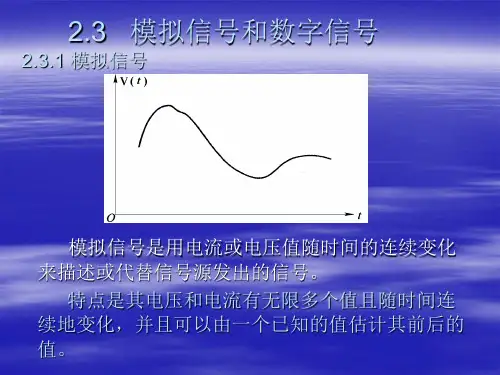
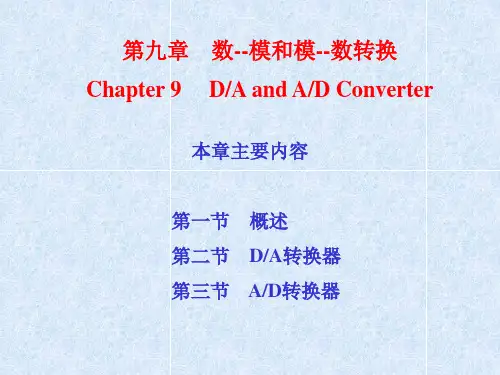
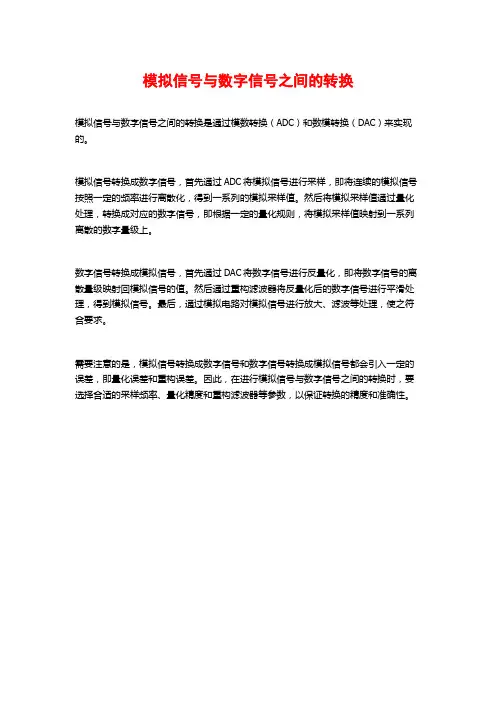
模拟信号与数字信号之间的转换
模拟信号与数字信号之间的转换是通过模数转换(ADC)和数模转换(DAC)来实现的。
模拟信号转换成数字信号,首先通过ADC将模拟信号进行采样,即将连续的模拟信号按照一定的频率进行离散化,得到一系列的模拟采样值。
然后将模拟采样值通过量化处理,转换成对应的数字信号,即根据一定的量化规则,将模拟采样值映射到一系列离散的数字量级上。
数字信号转换成模拟信号,首先通过DAC将数字信号进行反量化,即将数字信号的离散量级映射回模拟信号的值。
然后通过重构滤波器将反量化后的数字信号进行平滑处理,得到模拟信号。
最后,通过模拟电路对模拟信号进行放大、滤波等处理,使之符合要求。
需要注意的是,模拟信号转换成数字信号和数字信号转换成模拟信号都会引入一定的误差,即量化误差和重构误差。
因此,在进行模拟信号与数字信号之间的转换时,要选择合适的采样频率、量化精度和重构滤波器等参数,以保证转换的精度和准确性。
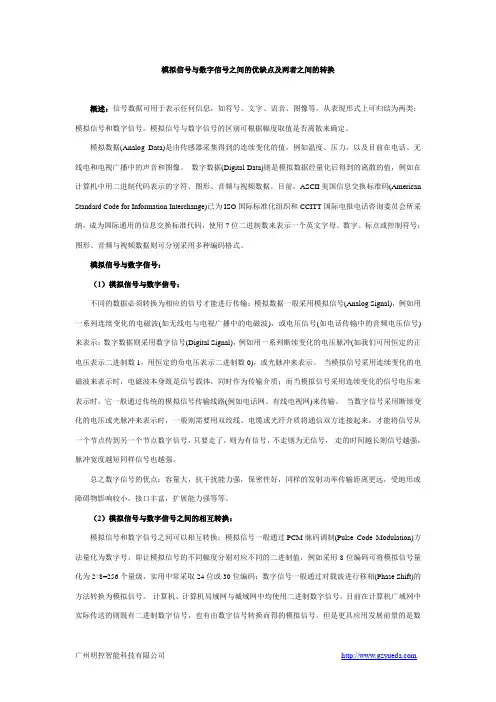
模拟信号与数字信号之间的优缺点及两者之间的转换概述:信号数据可用于表示任何信息,如符号、文字、语音、图像等,从表现形式上可归结为两类:模拟信号和数字信号。
模拟信号与数字信号的区别可根据幅度取值是否离散来确定。
模拟数据(Analog Data)是由传感器采集得到的连续变化的值,例如温度、压力,以及目前在电话、无线电和电视广播中的声音和图像。
数字数据(Digital Data)则是模拟数据经量化后得到的离散的值,例如在计算机中用二进制代码表示的字符、图形、音频与视频数据。
目前,ASCII美国信息交换标准码(American Standard Code for Information Interchange)已为ISO国际标准化组织和CCITT国际电报电话咨询委员会所采纳,成为国际通用的信息交换标准代码,使用7位二进制数来表示一个英文字母、数字、标点或控制符号;图形、音频与视频数据则可分别采用多种编码格式。
模拟信号与数字信号:(1)模拟信号与数字信号:不同的数据必须转换为相应的信号才能进行传输:模拟数据一般采用模拟信号(Analog Signal),例如用一系列连续变化的电磁波(如无线电与电视广播中的电磁波),或电压信号(如电话传输中的音频电压信号)来表示;数字数据则采用数字信号(Digital Signal),例如用一系列断续变化的电压脉冲(如我们可用恒定的正电压表示二进制数1,用恒定的负电压表示二进制数0),或光脉冲来表示。
当模拟信号采用连续变化的电磁波来表示时,电磁波本身既是信号载体,同时作为传输介质;而当模拟信号采用连续变化的信号电压来表示时,它一般通过传统的模拟信号传输线路(例如电话网、有线电视网)来传输。
当数字信号采用断续变化的电压或光脉冲来表示时,一般则需要用双绞线、电缆或光纤介质将通信双方连接起来,才能将信号从一个节点传到另一个节点数字信号,只要走了,则为有信号,不走则为无信号,走的时间越长则信号越强,脉冲宽度越短同样信号也越强。

模拟信号和数字信号可以实现相互转换。
模拟信号通常使用PCM(脉冲编码调制)方法量化并转换为数字信号。
PCM方法是使不同范围的模拟信号对应不同的二进制值。
例如,如果使用8位代码,可以将模拟信号量化为2^8 = 256个数量级。
在实践中,经常使用24位或30位代码。
通常,数字信号通过载波相移转换为模拟信号。
计算机,局域网,城域网都使用二进制数字信号。
目前,广域网的实际传输既有二进制数字信号也有数字信号转换的模拟信号。
但由于其更广泛的应用前景,数字信号更常用。
控制板(像Micro:bit,Arduino)指定的ADC接口,用于模拟量到数字量的转换。
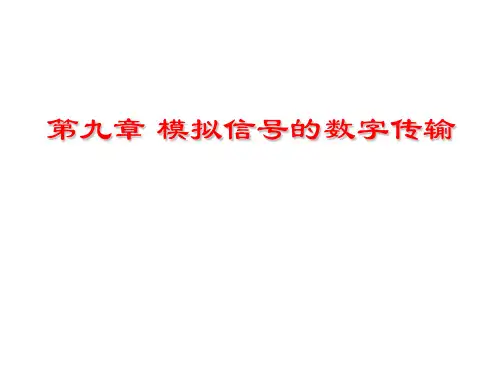
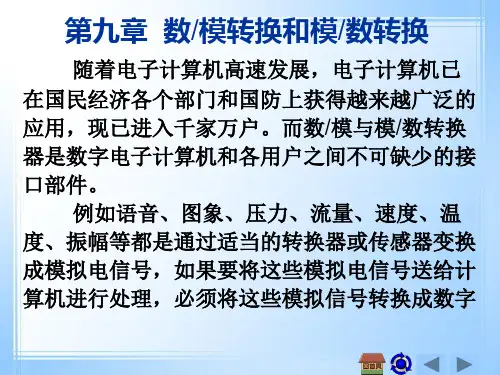

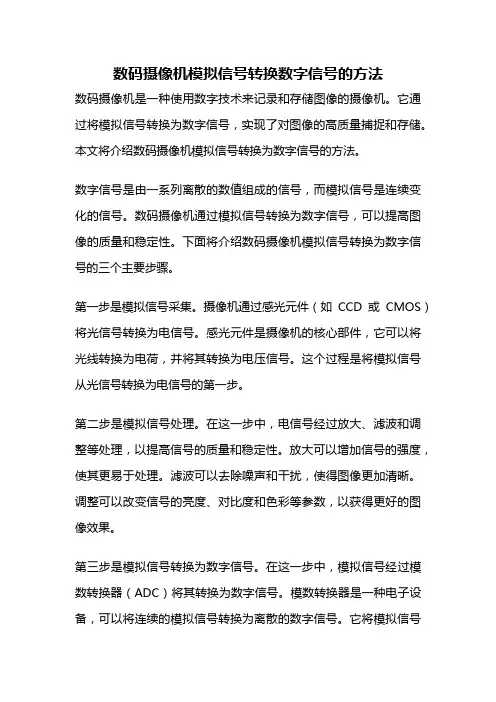
数码摄像机模拟信号转换数字信号的方法数码摄像机是一种使用数字技术来记录和存储图像的摄像机。
它通过将模拟信号转换为数字信号,实现了对图像的高质量捕捉和存储。
本文将介绍数码摄像机模拟信号转换为数字信号的方法。
数字信号是由一系列离散的数值组成的信号,而模拟信号是连续变化的信号。
数码摄像机通过模拟信号转换为数字信号,可以提高图像的质量和稳定性。
下面将介绍数码摄像机模拟信号转换为数字信号的三个主要步骤。
第一步是模拟信号采集。
摄像机通过感光元件(如CCD或CMOS)将光信号转换为电信号。
感光元件是摄像机的核心部件,它可以将光线转换为电荷,并将其转换为电压信号。
这个过程是将模拟信号从光信号转换为电信号的第一步。
第二步是模拟信号处理。
在这一步中,电信号经过放大、滤波和调整等处理,以提高信号的质量和稳定性。
放大可以增加信号的强度,使其更易于处理。
滤波可以去除噪声和干扰,使得图像更加清晰。
调整可以改变信号的亮度、对比度和色彩等参数,以获得更好的图像效果。
第三步是模拟信号转换为数字信号。
在这一步中,模拟信号经过模数转换器(ADC)将其转换为数字信号。
模数转换器是一种电子设备,可以将连续的模拟信号转换为离散的数字信号。
它将模拟信号的电压值转换为数字编码,以便于计算机进行处理和存储。
转换后的数字信号可以通过数字接口传输到计算机或其他存储设备中。
数码摄像机模拟信号转换为数字信号的方法可以提高图像的质量和稳定性。
与传统的模拟摄像机相比,数码摄像机具有更高的分辨率、更丰富的色彩和更低的噪声水平。
此外,数字信号的处理和存储也更加方便和灵活。
数字信号可以通过计算机软件进行后期处理和编辑,可以方便地进行图像增强、剪辑和分享等操作。
总结起来,数码摄像机通过将模拟信号转换为数字信号,实现了对图像的高质量捕捉和存储。
模拟信号转换为数字信号的过程包括模拟信号采集、模拟信号处理和模拟信号转换为数字信号三个主要步骤。
这种转换方法不仅提高了图像的质量和稳定性,还方便了图像的后期处理和编辑。
Conversion between analog signal and digital signal一、Analog signal and digital signal(1) analog signals and digital signalsAnalog data (Data Analog) is a continuous change of value, such as temperature, pressure, and sound and image in the telephone, radio and television broadcasting. Digital data (Data Digital) is the discrete values obtained after the quantization of analog data, such as characters, graphics, audio and video data in a computer. At present, ASCII American Standard Code for information interchange (American Standard Code for information interchange) is the international organization for standardization of ISO and CCITT International Telegraph and Telephone Consultative Committee adopted as international standard code for information interchange, use 7 bit binary numbers to represent a English letters, numbers, punctuation or control symbols, graphics, audio and video data can be respectively by a plurality of encoding format.Different data must be converted to the corresponding signal in order to transmission: simulated data generally use the analog signal (analog signal), such as a series of continuous change of the electromagnetic wave (such as radio and television broadcasting electromagnetic waves), or voltage signals (such as telephone transmission of audio voltage signal) to represent; digital data by the digital signal (digital signal), such as a series of discontinuous changes the voltage pulse (such as we can use constant positive voltage represents a binary number 1, with a constant negative voltage said binary number 0), or light pulses to represent. When the analog signal used to represent continuous variation of electromagnetic waves, electromagnetic wave itself is a signal carrier, also as the transmission medium; and when the analog signal with continuous variation of the signal voltage to represent, it generally through traditional analog signal transmission line (for example telephone network, cable TV network) to transmit. When the digital signal by intermittent changing voltage or pulses of light to said, generally need to communication between the two sides are connected by twisted pair cable or fiber optic media, in order to signals from a node spread to another node.(2) the mutual transformation between analog and digital signalsAnalog signal and digital signal can be converted into each other: analog signal general by PCM (pulse code modulation) method to quantify into a digital signal that analog signals of different amplitudes corresponding to different binary values, such as the use of 8-bit code the analog signal quantization 2^8=256 one order of magnitude, practical often takes 24 or 30 bits coding; digital signal by the carrier phase (phase shift) method converts analog signals. Computer, computer local area network and metropolitan area networks use binary digital signal, currently in wide area network of computer of an actual transmission both binary digital signal, converts the digital signals by the analog signal. But more applications are digital signals.二、PCM and DPCM modulation principle(1) PCM sketchPulse encoding modulation (PulseCodeModulation), referred to as PCM. Sampling, quantization, and digital signal generated by encoding for continuous variation of analog signals. The advantage of PCM is that the sound quality is good, the disadvantage is that the volume is big. PCM can provide users from the 2M to the 155M rate of digital data line business, but also can provide voice, image transfer, remote teaching and other business. PCM has two standards: E1 and T1.(2)PCM modulation principlePulse Modulation (Code Pulse modulation) is the most commonly used, the most simple waveform encoding. It is a direct and simple the speech by sampling, a / D conversion is obtained by digital uniform quantization for coding method, is the foundation of other coding algorithm, that is, the pulse code modulation is the analog signal to sampling, the sample value amplitude quantization and coding process.1) sampling is to periodically scan analog signals, the time continuous signal into discrete signal. The analog signal after sampling should also contain all the information in the original signal, which is to say that the original signal can be no distortion to restore the original signal. The lower limit of the sampling rate isdetermined by the sampling theorem. Sampling rate was 8Kbit/s.2) quantization, which is the instantaneous value of the sample to be discrete, that is, with a set of level, the instantaneous sampling value with the most close to the level value.A simulated signal is quantized by a quantized pulse amplitude modulation signal, which is only a finite number of values.3) encoding, is to use a set of binary code group to show that each has a fixed level of quantization. However, in fact, the quantification is in the process of encoding also completed, so the encoding process is also known as analog / digital conversion, can be written as A/D.(3)DPCM profileDPCM (pulse code modulation) that pulse code delta modulation is the voice signal correlation to identify can reflect the change characteristics of the signal, a differential coding is to sample the analog signal amplitude difference quantization coding modulation. This way is to predict the current sampling value by using the sampled values, and the difference between them is encoding. The difference between encoding and encoding can increase the frequency, this technology has been applied to analog signals in digital communications.DPCM is similar to the prediction of encoding, but it has a quantization step. The quantization step is similar to that of the quantization step in PCM, which can be uniform and uniform.For some signal (for example image signal) due to the relatively large signal transient slope, it is easy to cause overload, therefore, can not be used simple delta modulation encoding, in addition, the signal nor like voice signal that syllable characteristics and not the like syllable companding as the method, only the instantaneous companding method. But instantaneous companding more difficult to achieve. Therefore, the instantaneous slope for relatively large signal, usually by a comprehensive the delta modulation and pulse code modulation characteristics of both the modulation method for encoding. This encoding is referred to as incremental pulse code modulation, or differential pulse code modulation, DPCM said.模拟信号与数字信号之间的转换一、模拟信号与数字信号(1)模拟信号与数字信号模拟数据(Analog Data)是由传感器采集得到的连续变化的值,例如温度、压力,以及目前在电话、无线电和电视广播中的声音和图像。
第九章 数模(D/A )和模数(A/D )转换电路一、 内容提要模拟信号到数字信号的转换称为模—数转换,或称为A/D (Analog to Digital ),把实现A/D 转换的电路称为A/D 转换器(Analog Digital Converter ADC );从数字信号到模拟信号的转换称为D/A (Digital to Analog )转换,把实现D/A 转换的电路称为D/A 转换器( Digital Analog Converter DAC )。
ADC 和DAC 是沟通模拟电路和数字电路的桥梁,也可称之为两者之间的接口。
二、 重点难点本章重点内容有:1、D/A 转换器的基本工作原理(包括双极性输出),输入与输出关系的定量计算;2、A/D 转换器的主要类型(并联比较型、逐次逼近型、双积分型),他们的基本工作原理和综合性能的比较;3、D/A 、A/D 转换器的转换速度与转换精度及影响他们的主要因素。
三、本章习题类型与解题方法 DAC网络DAC 权电阻 ADC 直接ADC间接ADC权电流型DAC权电容型DAC开关树型DAC输入/输出方式 并行 串行 倒梯形电阻网络DAC这一章的习题可大致分为三种类型。
第一种类型是关于A/D 、D/A 转换的基本概念、转换电路基本工作原理和特点的题目,其中包括D/A 转换器输出电压的定量计算这样基本练习的题目。
第二种类型是D/A 转换器应用的题目,这种类型的题目数量最大。
第三种类型的题目是D/A 转换器和A/D 转换器中参考电压V REF 稳定度的计算,这种题目虽然数量不大,但是概念性比较强,而且有实用意义。
(一)D/A 转换器输出电压的定量计算【例9 -1】图9 -1是用DAC0830接成的D/A 转换电路。
DAC0830是8位二进制输入的倒T 形电阻网络D/A 转换器,若REF V =5 V ,试写出输出电压2O V 的计算公式,并计算当输人数字量为0、12n - (72)和2n -1(82-1)时的输出电压。
数码摄像机模拟信号转换数字信号的方法数码摄像机模拟信号转换数字信号的方法是将模拟信号转换为数字信号,以便更好地存储、传输和处理图像和视频数据。
本文将介绍数码摄像机模拟信号转换为数字信号的原理和方法。
一、数码摄像机模拟信号转换数字信号的原理数码摄像机的工作原理是通过感光元件(如CCD或CMOS)将光信号转换为电信号,然后经过模拟信号处理电路进行处理和增强,最后将模拟信号转换为数字信号。
这样可以保留更多的图像细节和颜色信息,并且具有更好的稳定性和抗干扰能力。
二、数码摄像机模拟信号转换数字信号的方法1. 采样:数码摄像机通过采样将模拟信号转换为离散的数字信号。
采样是指以一定的时间间隔对模拟信号进行取样,将其转换为一系列离散的数字值。
采样频率越高,取样的精度越高,能够更准确地还原原始信号。
2. 量化:采样后得到的连续模拟信号需要进行量化处理,将其转换为离散的数字信号。
量化是指将采样得到的模拟信号值映射为离散的数字信号值。
量化的目的是将连续的信号值转换为离散的有限个数值,以便于存储和处理。
3. 编码:量化后的信号需要进行编码,将其表示为数字形式。
编码是指将离散的量化数值转换为二进制码,以便于存储和传输。
常用的编码方法有脉冲编码调制(PCM)、差分脉冲编码调制(DPCM)等。
4. 数据处理:经过编码后的数字信号可以进行各种图像和视频处理操作,如降噪、增强、压缩等。
这些处理操作可以提高图像和视频的质量,减小存储和传输所需的容量。
5. 数字信号输出:经过处理后的数字信号可以通过各种接口输出,如USB、HDMI等。
这样可以方便地将图像和视频数据传输到计算机、电视等设备上进行播放、编辑和存储。
三、数码摄像机模拟信号转换数字信号的优势1. 高清晰度:数字信号具有更高的分辨率和更丰富的颜色信息,可以呈现更清晰、更真实的图像和视频。
2. 抗干扰性强:数字信号通过编码和差错校正等处理,具有更好的抗干扰能力,能够在传输过程中保持图像和视频的稳定性和一致性。
数字信号转模拟信号的过程
数字信号转模拟信号是数字信号处理中的一种重要技术,它将离散的数字信号转换为连续的模拟信号,从而使数字信号能够被传输、处理和应用于模拟系统中。
数字信号转模拟信号的过程可以分为三个主要步骤:采样、量化和编码。
第一步是采样。
在数字信号处理中,采样是将连续的模拟信号转换为离散的数字信号的过程,因为计算机和数字系统只能处理数字信号。
在数字信号转模拟信号的过程中,采样是将数字信号转换为模拟信号的第一步。
采样过程通常由模拟-数字转换器(ADC)完成,通过传感器将模拟信号转换为数字信号。
采样率是表示数字信号每秒采样次数的单位,通常以赫兹(Hz)为单位。
第二步是量化。
量化是将采样过程中获得的数字信号映射到固定数量的离散级别上的过程。
在模拟信号中,任何信号都可以采用任意精度进行表示。
但在数字信号中,由于计算机的存储能力有限,数字信号必须通过量化的方式,将其映射到有限的离散级别上。
量化级别越高,数字信号就越接近于模拟信号,但相应地,存储和处理数字信号所需的空间和计算时间也将增加。
通常,量化级别以比特数(比特数越高,量化级别越高)表示。
第三步是编码。
编码是将量化过程中获得的数字信号转换为连续的模拟信号的过程。
编码通常由数字-模拟转换器(DAC)完成,通过将数字信号恢复为模拟信号。
编码通常使用不同的方法,包括脉冲编码调制(PCM),脉冲宽度调制(PWM)和脉冲位置调制(PPM)等,不同的编码方法具有不同的性能和适用范围。